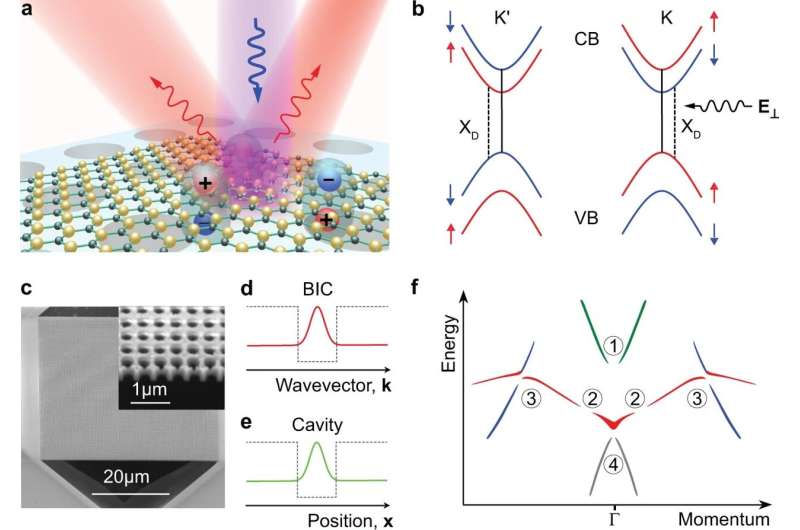Brightening dark excitons with photonic crystals

Researchers are working to improve 2D semiconductors by better understanding dark excitons and how they could be applied to future technologies ranging from quantum computers to next-generation solar panels.
Dr. Shoufeng Lan, assistant professor in the J. Mike Walker '66 Department of Mechanical Engineering at Texas A&M University, is leading a project to explore how the optically inactive "dark" variant of excitons—the bound state of an electron and electron-hole pair often found in semiconductors—can be accessed and manipulated in a new way. This would allow for a variety of applications in quantum materials.
The discoveries from the research support a better understanding of the fundamental aspects of dark excitons, with potential implementation in future next-generation devices, quantum computers and more efficient solar panels.
"This demonstration is poised to pave the way for applications such as quantum information processing, quantum computing, photonic circuitry and valleytronics that use the fascinating features of dark excitons for encoding and transporting information," Lan said.
The research, titled "Coherent momentum control of forbidden excitons," was published recently in the journal Nature Communications.
Excitons can be found in two variations: optically bright or dark. Bright excitons can emit photons—massless particles for light—whereas dark excitons are typically optically inactive but boast a longer radiative lifetime. The latter is a feature that Lan said is particularly interesting as the team explores ways to implement dark excitons in quantum information processing.
The research team was able to outline a more efficient, low-loss solution to the dilemma posed by dark excitons by reintroducing photonic bound states in the continuum (BICs) to manipulate them in a momentum-space photonic environment. Lan said this platform could be used to redefine the light-matter interactions produced in nearby quantum materials, which would be challenging or impossible to accomplish otherwise.
"Using photonic crystals that support photonic BICs, the research demonstrated the brightening of dark excitons and obtained coherent, directional photoemission from them at room temperature," Lan said.
Compared to approaches that use external stimuli—such as a strong magnetic field—the team's use of photonic crystals with lossless insulators showed to be more compatible with semiconductors and photonic circuitry while also enabling control of the directionality.
Looking ahead, the team is working to improve the design and implementation of their BICs with a plan to develop low-threshold lasers and quantum phenomena and devices at the nanoscale.
"One typically uses supercomputers with commercial software to simulate the spectral responses by scanning all parameters—experimental conditions, geometries, material properties, etc.—which can take days, if not weeks," Lan said. "Using artificial intelligence with deep learning, we could increase the speed of this process significantly."
The team's research on using artificial intelligence with deep learning for photonic BICs was published earlier this year in the journal Laser & Photonics Reviews.
More information: Xuezhi Ma et al, Coherent momentum control of forbidden excitons, Nature Communications (2022). DOI: 10.1038/s41467-022-34740-5
Xuezhi Ma et al, Strategical Deep Learning for Photonic Bound States in the Continuum, Laser & Photonics Reviews (2022). DOI: 10.1002/lpor.202100658
Journal information: Nature Communications
Provided by Texas A&M University College of Engineering





















